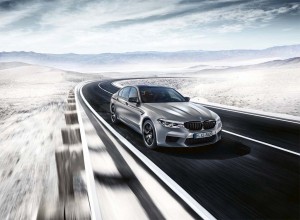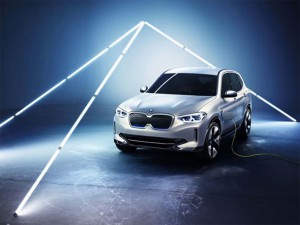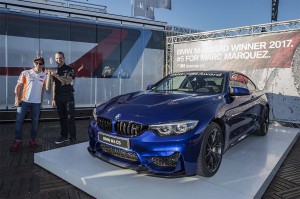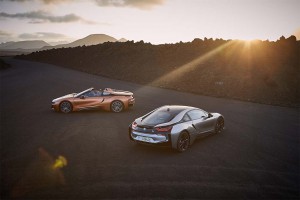
Don't be surprised to see next-generation BMW M models adopt hybrid or even all-electric drive technology, the brand's chief said.
If anyone still has doubts about the expanding role of battery powertrain technology in the luxury car market, comments from Frank Van Meel, the head of BMW’s vaunted M brand, should put them to rest.
During a media event in Spain, Van Meel told a group of Australian journalists that “all M vehicles wil be electrified by the end of the next decade,” a shift that will include a mix of hybrid and all-electric vehicles.
If the comments, first published by CarAdvice, are accurate, it puts BMW M in line with what we’re seeing from a number of other high-line automakers and, more notably, with what high-performance brands are planning. All future Maserati and Alfa Romeo models, for example, will be offered with some form of electrified option and Alfa’s reborn 8C supercar will use a plug-in hybrid all-wheel-drive system to punch out over 700 horsepower.
(BMW’s iX3 concept reveals brand’s new approach to electrification. Click Here for more.)
The interest in going electric is no surprise, especially not as battery technology rapidly improves. Compared with what was available at the beginning of the decade, current lithium-ion technology is smaller, lighter and both more power and energy dense. (Power density means it can punch out more watts faster, energy density referring to how many kilowatts a battery of a given size can store.)
Prices have also tumbled. A kilowatt-hour of lithium cells cost about $1,000 in 2010 but is now averaging around $150, according to industry insiders, with the Boston Consulting Group “conservatively” forecasting that figure will be cut in half within five years.
For BMW M, the electrification process is “going to happen step-by-step,” Van Meel said. “The important question is the timing question – what’s the right time for that? If you’re too late then you’re too late, but if you’re too early then you don’t have the ‘straight to the point technology.”
Even with the improvements seen this decade, the M chief cautioned that “today’s electrification components…are quite heavy and, for us as a motorsports company, overall vehicle weight and power-to-weight ratio is key.”
While batteries still add quite a bit of mass to a vehicle there is a positive side. By using a skateboard-like layout, mounting a pack under the load floor, that can lower the center of gravity below what a vehicle might have with a conventional gasoline engine. That’s been clearly shown by the new Jaguar I-Pace SUV which has been receiving rave reviews for its handling, as well as its performance.
(For more on BMW’s plans to up EV and AV spending, Click Here.)

BMW plans to take a shot back at Tesla with a series of new BEVs. The iX3 concept it revealed in Beijing is shown here.
Battery-electric powertrains can offer other advantages, starting with the fact that electric motors deliver maximum torque the moment they start spinning. Even in Formula One racing that is a plus and the F1 KERS-style hybrid system has now been used on a number of hypercars, such as the Porsche 917 Spyder and McLaren P1.
BMW was one of the first high-line manufacturers to push into electrification, setting up the i brand with models like the i3 city car and high-performance i8 plug-in hybrid. It has decided to shift away from the original plan to use specially developed platforms for the i line-up, however. In the future, while some electric models may have distinctive body designs they will share underlying platforms with conventional BMW models. The key difference will be the flexibility to squeeze batteries into the load floor of electrified versions.
In April, BMW showed the new iX3 as an example of what’s coming, the electrified version of the X3, in concept form, using a 70 kWh battery to achieve 250 miles range.
BMW has developed a mix of modular motor drive systems that could be described as small, medium, large and extra-large. They will be able to be mixed and matched to provide front-wheel-drive, rear-drive or all-wheel-drive.
Any individual model will be able to use up to three packs, one in front and two in the rear, Tom Plucinsky, the head of technology communications, delivering up to a combined 750 kilowatts of power recently told TheDetroitBureau.com. That works out to as much as 1,000 horsepower, “which is M-car territory,” he suggested. BMW is estimating that package could see 0-to-60 mph times of well under 3 seconds.
The current i8 model, which mixes a turbo-gas engine with multiple electric motors, uses a two-speed transmission. Going forward, Plucinsky noted, the plan is to rely on one-speed transmissions because of the incredible RPM range electric motors can operate at with great efficiency.
Those electric motors, meanwhile, will draw power from one of three modular battery packs now under development:
- A 60 kilowatt-hour pack expected to yield as much as 450 kilometers, or 280 miles, range;
- A 90 kWh pack delivering up to 550 km, or 342 miles, range; and
- A 120 kWh pack capable of up to 700 km, or 435 miles range – the pack expected to be used in the upcoming i4.
One thing is clear, Van Meel told the Australian journalists: “If we do an M car in an electrified way, it should still drive like an M. The basic target is no so much the components of the technology itself. It’s more the philosophy.”
(Why are Alfa Romeo and Maserati betting big on batteries? Click Here to find out.)


